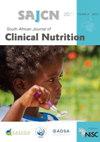Profile of mothers whose children are treated for malnutrition at a rural district hospital in the North West province, South Africa
IF 0.6
Q4 NUTRITION & DIETETICS
引用次数: 2
Abstract
Objective: This study profiled mothers whose children were admitted to hospital for malnutrition in a rural hospital in the North West province. Method: A quantitative and cross-sectional design, using a researcher-developed questionnaire, was used to collect data from 94 mother and child pairs who were admitted to hospital for malnutrition. Stata statistical software was used to analyse the data. Results: The ages of the mothers ranged from 17 to 48 years. Most (83%) lived in dwellings that had electricity, and 92% had running water in their households. Some 83% were not married and 97% were unemployed. Mothers between the ages of 21 and 25 years had the highest number of children with malnutrition (37%, n = 34), followed by mothers between the ages of 26 and 30 years (28%, n = 26). Severe acute malnutrition was experienced by children whose mothers were comparatively young (age group 16–20), accounting for 44.4% of malnourished children. The association between category of malnutrition and maternal age was not statistically significant. Conclusion: Although malnutrition of the children cuts across all maternal age groups, severe acute malnutrition tends to occur among children whose mothers are either young or relatively older, which suggests a need for specific community-based interventions among these groups of mothers.孩子在南非西北省一家农村地区医院接受营养不良治疗的母亲简介
目的:本研究介绍了西北省一家农村医院因营养不良而入院的母亲。方法:采用定量和横断面设计,使用研究人员编制的问卷,收集94对因营养不良入院的母子的数据。使用Stata统计软件对数据进行分析。结果:母亲的年龄在17~48岁之间。大多数人(83%)住在有电的房子里,92%的家庭有自来水。约83%的人没有结婚,97%的人失业。21岁至25岁的母亲营养不良的儿童数量最多(37% = 34岁),其次是年龄在26岁至30岁之间的母亲(28% = 26)。母亲年龄相对较小的儿童(16-20岁)出现严重急性营养不良,占营养不良儿童的44.4%。营养不良类别与产妇年龄之间的相关性没有统计学意义。结论:尽管儿童营养不良涉及所有母亲年龄组,但母亲年龄较小或相对较大的儿童往往会出现严重急性营养不良,这表明需要在这些母亲群体中采取具体的社区干预措施。
本文章由计算机程序翻译,如有差异,请以英文原文为准。
求助全文
约1分钟内获得全文
求助全文
来源期刊

South African Journal of Clinical Nutrition
NUTRITION & DIETETICS-
CiteScore
2.50
自引率
9.10%
发文量
21
期刊介绍:
1.The Journal accepts articles from all basic and applied areas of dietetics and human nutrition, including clinical nutrition, community nutrition, food science, food policy, food service management, nutrition policy and public health nutrition. 2.The Journal has a broad interpretation of the field of nutrition and recognizes that there are many factors that determine nutritional status and that need to be the subject of scientific investigation and reported in the Journal. 3.The Journal seeks to serve a broad readership and to provide information that will be useful to the scientific community, the academic community, government and non-government stakeholders in the nutrition field, policy makers and industry.
 求助内容:
求助内容: 应助结果提醒方式:
应助结果提醒方式:


